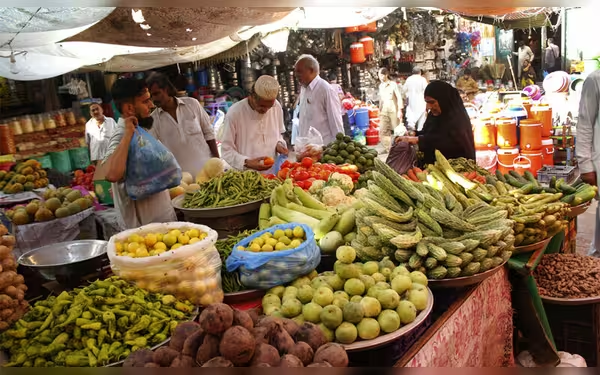Saturday, November 16, 2024 07:45 PM
Pakistan's Inflation Rate Drops to 44-Month Low Amid Economic Challenges
- Inflation rate falls to 6.9 percent in September.
- Concerns remain over rising prices of essential goods.
- Government initiatives aim to boost agricultural production.
 Image Credits: dawn
Image Credits: dawnPakistan's inflation rate has dropped to 6.9%, but essential goods prices rise, highlighting ongoing economic challenges.
Inflation is a term that often brings concern to many households and businesses. It refers to the general increase in prices and the fall in the purchasing value of money. In Pakistan, the structural theory of inflation suggests that inflation arises from weaknesses in the country’s ability to produce goods or maintain a steady supply. When there is not enough production, it creates an imbalance between supply and demand, leading to rising prices. This type of inflation is not easily controlled by monetary policy, which is the actions taken by the government to manage the economy.
Recently, Finance Minister Muhammad Aurangzeb announced that the inflation rate in Pakistan has dropped to a 44-month low of 6.9 percent in September. This decline is attributed to several factors, including a steady decrease in global commodity prices, an increase in domestic agricultural production, and a stable currency rate. However, it is important to note that this drop in inflation is also influenced by a high-base effect from the previous year when inflation was significantly higher at 31.4 percent.
Despite the positive news, there are still concerns regarding the effectiveness of the State Bank’s traditional monetary tools. Younus Dagha, the Chairman of the Policy Research and Advisory Council, has raised questions about why inflation continues to rise even after consecutive interest rate hikes. He emphasizes the need for a closer examination of the factors contributing to the recent decline in inflation.
Different stakeholders have varying opinions on the situation. For instance, Mohammed Sohail, CEO of Topline Securities, believes that aggressive monetary tightening has played a crucial role in bringing inflation below 7 percent ahead of schedule. On the other hand, Prime Minister Shehbaz Sharif views the drop in inflation as evidence of the government’s commitment to stabilizing the economy.
While the overall inflation rate has decreased, the prices of essential goods and services continue to rise. The weekly sensitive price index, which tracks the prices of essential items, increased by 13.18 percent in early October due to higher prices of perishable vegetables. Core inflation, which excludes food and energy prices, remains a concern, recorded at 9.3 percent in urban areas and 12.1 percent in rural areas.
Experts categorize the causes of inflation into three main groups: demand-pull, cost-push, and inflation expectations. A significant issue for Pakistan is its balance-of-payments crisis, which arises when domestic production in agriculture and industry fails to meet the growing demand, leading to increased imports. Former State Bank Governor Dr. Ishrat Hussain suggests that expanding the agriculture, industry, and export sectors through investment and productivity improvements is essential to address this issue.
In response to these challenges, provincial governments are taking initiatives. For example, Sindh’s Chief Minister has directed the agricultural department to analyze crop markets and encourage local farmers to grow crops that are currently imported. Additionally, Rs8 billion has been allocated to incentivize small growers to produce wheat and other crops. In Punjab, the government is implementing a centralized approach to control food inflation and ensure food security by consolidating various agencies under a new department focused on price control and commodities management.
Despite these efforts, the agricultural sector faces significant challenges. The number of cotton ginning factories has drastically decreased, and Pakistan now spends billions on cotton imports, a stark contrast to its previous status as a global leader in cotton production. This situation highlights the need for a robust strategy to revitalize the agricultural sector.
While the recent decline in inflation is a positive development for Pakistan’s economy, it is crucial to address the underlying structural issues that contribute to inflation. By focusing on enhancing domestic production capabilities and implementing effective policies, the government can work towards achieving a more stable economic environment. The journey to economic stability is complex, but with continued efforts and strategic planning, there is hope for a brighter financial future for the nation.













